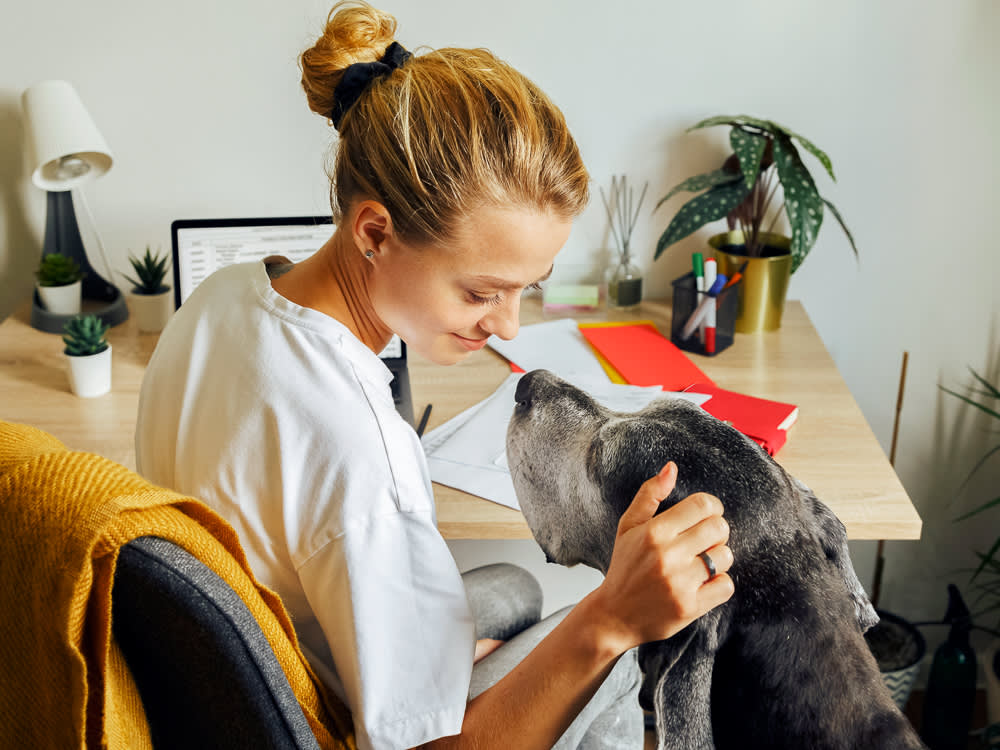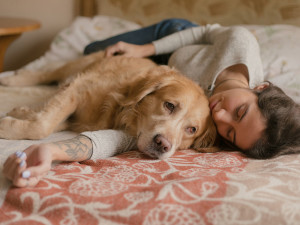How to Speak “Dog”
Lili Chin’s book Doggie Language illustrates how dogs communicate — beyond ear perks and tail wags.
Lili Chin wants to help you understand your dog better. Your pup may not be able to talk but they have a lot to say — and it gets communicated in more ways than you might think (there’s so much more to it than barks and tail wags). Chin, who has been drawing dogs for over 20 years, has illustrated dozens of canine-body-language charts for a number of organizations including shelters, law-enforcement training programs, the World Health Organization, the Dog Decoder mobile appopens in new tab and even the Swiss Fire Brigade. She also was co-creator of the Warner Brothers’ hit animated series Mucha Luchaopens in new tab. Chin has captured her drawings in her recent book, Doggie Languageopens in new tab, which decodes canine body language so you can understand the subtle clues your dog is giving you. Here, she tells us what inspires her, plus why it’s so important for pet parents to speak “dog” in the first place.
Why is it important for people to be able to understand and speak “dog”?
Speaking as an artist who lives with a dog and someone who has worked for professional dog behavior consultants, I feel it’s important so that people and dogs can have better relationships. With dog body-language knowledge, people can avoid getting bitten and are less likely to unintentionally hurt dogs due to misinterpretations of what they’re seeing.
Over the years, I’ve illustrated several “dog bite prevention” infographics. A key message is that dogs don’t bite out of the blue. But when their (silent) requests for space are ignored or misinterpreted, they are more likely to escalate to aggressive behaviors like growling or biting. So, learning dog body language is also important for the safety of humans. Not all tail wags are friendly and neither is all eye-contact.
If we know how to listen to dogs, we can help them when they’re stressed. We can change what we’re doing or arrange things so they feel safe. We can know if they are enjoying an experience, or hating it, or are confused by it. Basically, I think that learning dog body language is essential to dogs’ health and welfare.
How much do you spend on your pet per year?
Are there artistic challenges to representing dog behavior in drawings?
I’ve been a professional artistopens in new tab since the 90s and have a background in hand-drawn animation, so I have a good amount of experience drawing characters in different poses with different expressions to show changes in movement. I have also drawn many dog body language charts for dog trainers and welfare organizations, which has exposed me to lots of visual reference material.
Plus, I have my own dog — Boogie, a Boston Terrier — as a model. I think the biggest challenge is learning to see nuances and details so I can represent these accurately within a style that is simple (and not photorealistic). I seek out photos and get feedback from professionals to make sure I’m getting it right.
How did you learn to read a dog’s behavior?
The first step is seeing. There was a time when I was oblivious to many of the small behaviors listed in this book. I saw the big behaviors, but not the tiny ones. When I saw my first “lip lick” for instance, and learned that this is a sign of discomfort or concern, I could no longer not see lip licks. The second step is looking at the whole body in context. What changed in the environment? How did the dog’s posture, eyes, ears, tail and mouth change in reaction to that change?
It also takes knowing dogs as individuals — age, breed, health, unique experiences. For example, Boogie, who’s now 16, is deaf, blind, may have a brain tumor, and no longer moves like he used to. He often looks stiff and moves slower, and his rounded back-end makes him look like he’s scared or about to do a number two, but I know this is actually due to his age and neurological issues.
Which experts have influenced you?
Here are the people who have had the biggest impact on my education and work, but there have been so many! I feel like I’m still always learning.
Turid Rugaasopens in new tab. I was first introduced to Turid Rugaas’s calming signals by our trainer, Sarah Owings. This was back around 2009. According to Rugaas, signals like lip-licks, head-turns, blinks, and shake-offs are natural behaviors displayed between dogs to prevent and resolve social conflicts and to communicate peacefully. This was my introduction to dog body language, and it was life-changing for me. Until then, all I knew about dog behavior was the debunked “dominant-submissive” stuff I had seen on TV.
Sophia Yin, DVM, MSopens in new tab. I had been a fan of Dr. Sophia Yin since her early dominance controversy articleopens in new tab. Working as Dr. Yin’s illustrator for three years, I learned about operant conditioning (the science of behavior and positive-reinforcement-based training) and also illustrated many posters on how to interact with dogs in ways that don’t stress them out. Dr. Yin’s “Dog Bite Prevention” and “Low-Stress Handling” PSAs emphasized recognizing signs of fear and stress in dogs.
Grisha Stewart, MA, CPDT-KAopens in new tab. I had a reactive dog who had bitten people, so learning Grisha Stewart’s humane BAT protocolopens in new tab for reactivity, aggression and frustration in dogs and illustrating her book were big deals. I learned how crucial it was to be able to see the subtle changes in a dog’s body language—from relaxed to curious to tense—when they’re in the presence of a trigger so we can help them stay unstressed throughout the training process. These subtle changes in body language are important to know in any sort of rehab, where we are helping change our dog’s feelings from negative to positive.
Amy Cook, PhDopens in new tab. Earlier this year, I attended a Play Way workshop presented by Dr. Cook on the use of social play in therapy for reactive/aggressive dogs. My biggest takeaway from this event was how to play with our dogs without toys or food. What Dr. Cook calls “social play” is a dialogue with body language, which means that being sensitive to our dog’s body language, matching their energy level, responding to breaks and so forth are super important. I also learned the name for a particular “play face” and that dogs laugh.
What do you base your drawings on — photographs, real-life dogs, your own dog?
When I’m drawing my own dog, I look at him or draw from memory because I know him so well. A few Boston Terrier drawings in the book were inspired by Boogie.
When drawing any other dog, I prefer to look at photos for reference or inspiration. My reference material was basically what I had on my bookshelf — photos in Brenda Aloff’s Canine Body Language and Barbara Handelman’s Canine Behavior — and the internet. I also watched many videos on YouTube, and friends sent me photos of their dogs doing different things in different situations.
One challenge for me was drawing dogs with floppy ears and different kinds of tails. As Boogie doesn’t have floppy ears or much of a tail, I requested photos from dog trainers in a private Facebook group, and people were very generous in sharing photos of their own dogs with floppy ears and different body types. That was very helpful. I hope this book opens up awareness about dog body language and helps people see what they may not have noticed before. I also hope it makes talking and learning about this subject interesting and fun!





